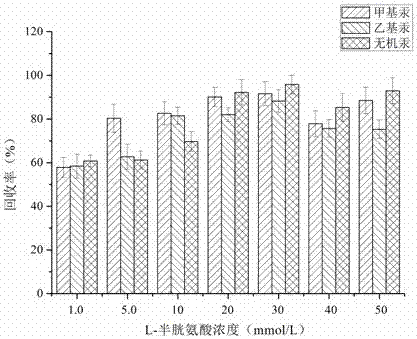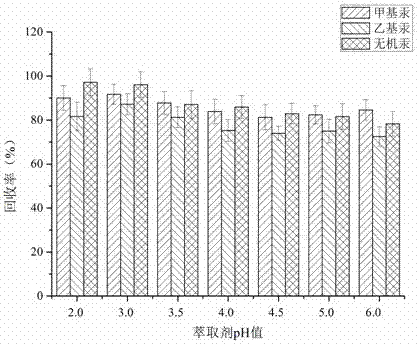A method for detecting methylmercury, ethylmercury and inorganic mercury in aquatic feed
A technology for aquatic feed and methylmercury, which is applied in the field of simultaneous extraction and detection of methylmercury, detection of methylmercury, ethylmercury and inorganic mercury in aquatic feed, which can solve the unpredictable detection effect, health hazards of experimenters, separation The conditions are cumbersome and other problems, and the reagents are green and non-toxic, the method is simple, and the extraction process is simple.
- Summary
- Abstract
- Description
- Claims
- Application Information
AI Technical Summary
Problems solved by technology
Method used
Image
Examples
Embodiment 1
[0040] This embodiment proposes a method for detecting methylmercury, ethylmercury and inorganic mercury in aquatic feed, comprising the following steps:
[0041] A, take the aquatic feed sample and make it into powder after drying, add L-cysteine, after shaking and centrifuging, extract the supernatant and filter to prepare the sample to be tested;
[0042] B. After preparing the sample to be tested with L-cysteine into a test solution with a concentration of 10 μg / L, use high performance liquid chromatography-cold vapor generation atomic fluorescence spectrometer for detection, and the detection conditions meet:
[0043] Mobile phase: a mixed solution composed of 5% (v / v) acetonitrile, 60 mmol / L ammonium acetate and 10 mmol / L L-cysteine,
[0044] Flow rate: 0.8 mL / min, injection volume: 80 μL,
[0045] Lamp current: 25 mA, multiplier tube negative high voltage: 250 mA,
[0046] Carrier gas: Ar,
[0047] Oxidant: 1% K by mass to volume 2 S 2 o 8 and 3% NaOH,
[0048] R...
Embodiment 2
[0051] The method for the detection of methylmercury, ethylmercury and inorganic mercury in the aquatic feed involved in the present embodiment comprises the following steps:
[0052] A, take the aquatic feed sample and make it into powder after drying, add L-cysteine, after shaking and centrifuging, extract the supernatant and filter to prepare the sample to be tested;
[0053] B. After preparing the sample to be tested with L-cysteine into a test solution with a concentration of 10 μg / L, use high performance liquid chromatography-cold vapor generation atomic fluorescence spectrometer for detection, and the detection conditions meet:
[0054] Mobile phase: a mixed solution composed of 5% (v / v) acetonitrile, 60 mmol / L ammonium acetate and 10 mmol / L L-cysteine,
[0055] Flow rate: 1.2 mL / min, injection volume: 120 μL,
[0056] Lamp current: 35 mA, multiplier tube negative high voltage: 300 mA,
[0057] Carrier gas: Ar,
[0058] Oxidant: 3% K by mass to volume 2 S 2 o 8 ...
Embodiment 3
[0062] The difference between this example and Example 1 is that in step A involved in this example, the aquatic feed sample was dried at 55° C. for 20 h, and then powdered by a pulverizer.
PUM
 Login to View More
Login to View More Abstract
Description
Claims
Application Information
 Login to View More
Login to View More - R&D Engineer
- R&D Manager
- IP Professional
- Industry Leading Data Capabilities
- Powerful AI technology
- Patent DNA Extraction
Browse by: Latest US Patents, China's latest patents, Technical Efficacy Thesaurus, Application Domain, Technology Topic, Popular Technical Reports.
© 2024 PatSnap. All rights reserved.Legal|Privacy policy|Modern Slavery Act Transparency Statement|Sitemap|About US| Contact US: help@patsnap.com










